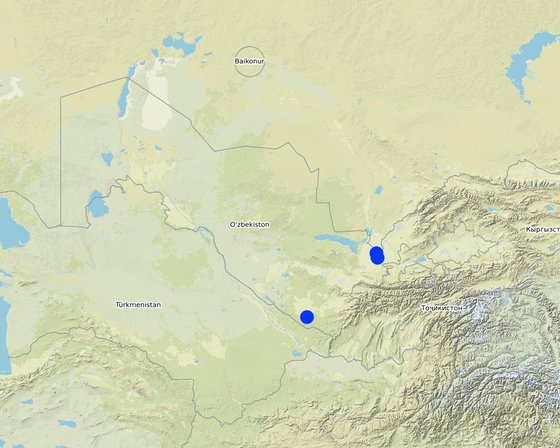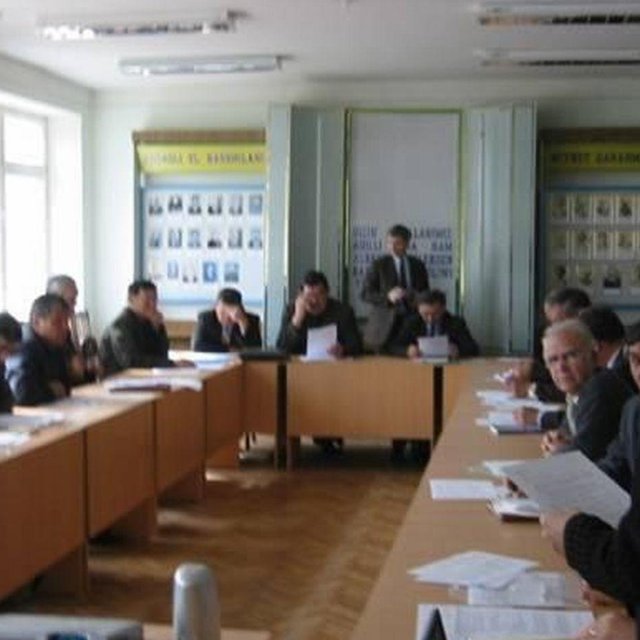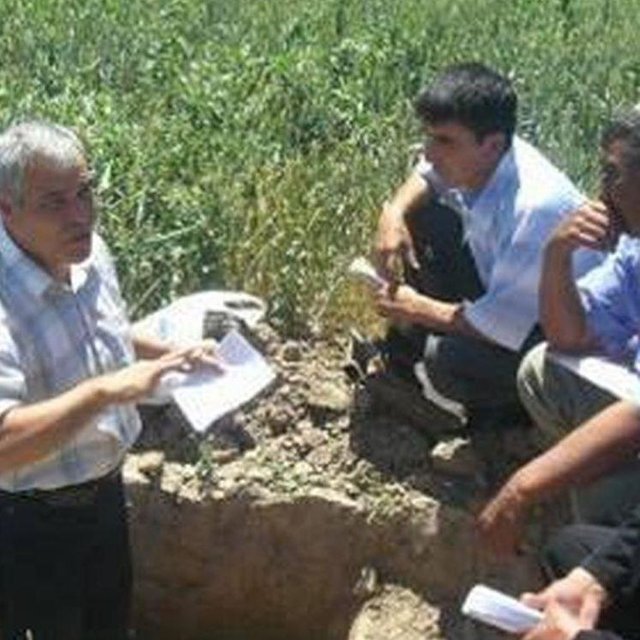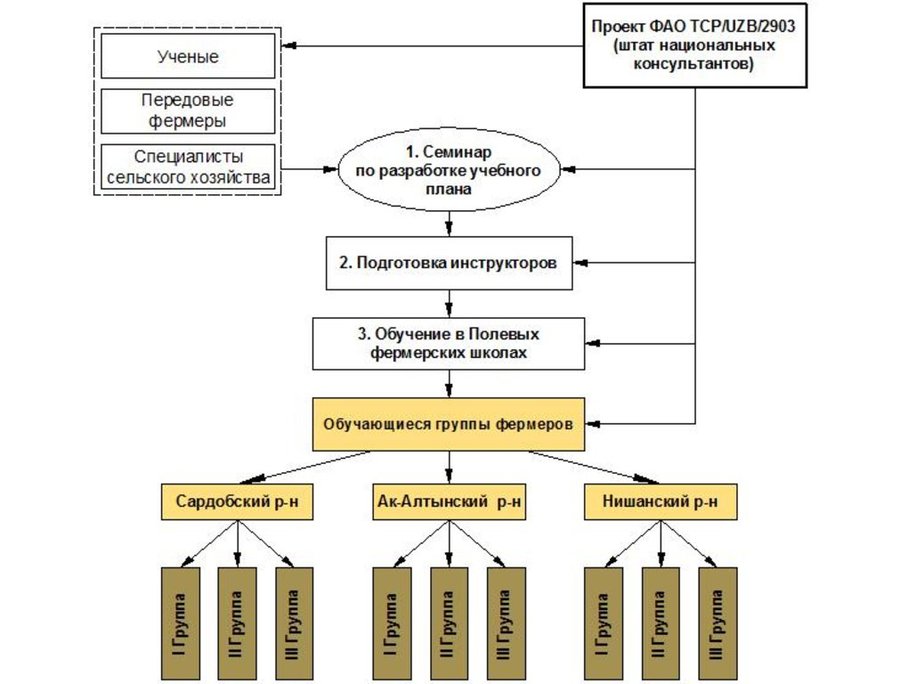Farmer Field Schools for improved agricultural practices in the irrigation zones of Uzbekistan
(Uzbekistan)
Central Asian Countries’ Initiative for Land Management (CACILM)
Description
The training of farmers in sustainable agronomic and irrigation practices aimed at improving and increasing the productivity of soil (in the frame of CACILM).
Aims / objectives: Most of Uzbekistan’s irrigated lands are affected by degradation processes, the most widespread of which include: (i) resalinization, (ii) water logging and raising water tables, (iii) loss of organic matter and reduction in soil fertility. The main goal of the Farmer Field Schools (FFS) is to train farmers in the best practices of cultivating crops on salinity and water logging affected gypsum-bearing soils and the , effecient use of irrigation water to increase land productivity and crop yield. FFS in the irrigated zone of Uzbekistan were established under the framework of the FAO project “Integrated management for sustainable use of salt affected and gypsiferous soils” (2002-2004).
Methods: The project’s FFS component was implemented by the Uzgipromeliovodhoz Institute under Ministry of Agriculture and Water Resources. The national consultants’ workgroup from Uzgipromeliovodhoz Institute, led by the national Project Director, organized and managed training in the FFS. FFS trainee groups comprised of farmers from the project areas who volunteered to participate. Training was conducted by the trainers using jontly elaborated training confirmed modules. The training, which was performed in the field where the farmers were introduced to sustainable agronomic practices, proved to be effective. Theoretical knowledge was taught in the machinery and tractor depots, and in rural school classrooms.
FFS also used the method of mass information transfer in order to facilitate adoptation of improved irrigation practices by a large number of farmers. This included the distribution of printed materials, highlighting the issues of rehabilitating degraded land, the preservation and increase of soil fertility, crop cultivation practices.
Stages of implementation:
I. Development of curriculum. Three-day workshop, headed by a FAO international consultant. This consultant, jointly with scientists and experts in agriculture and water resources and the leading farmers, developed the curriculum as well as approved the subject and content of the training modules.
II. Training of trainers (tutors). For three weeks, trainers underwent a Training of Trainers workshop. Candidate trainers were selected from among the project experts, local scientists, qualified farmers with higher education degrees in agriculture and working experience in this field.
III. Training of farmers. The organization of the FFS in the project areas was headed by national consultants and supported by local project experts. The farmers from the project areas were assembled into groups of 20-25 people each. Training was conducted by the FFS trainers.
Location

Location: Ak-Altyn, Sardoba and Nishan districts, Uzbekistan/Syrdarya, Kashkadarya oblast, Uzbekistan
Geo-reference of selected sites
-
65.62194, 38.5793
-
68.3868, 40.38904
-
68.35071, 40.5145
Initiation date: 2002
Year of termination: 2004
Type of Approach
-
traditional/ indigenous
-
recent local initiative/ innovative
-
project/ programme based

First stage in the creation of the Farmers’ Field Schools. Curriculum development workshop (R.Ibragimov)

Second stage in the creation of the FFS. Training of FFS trainers. Practical lessons in the analyzing of soil properties (R.Ibragimov)
Approach aims and enabling environment
Main aims / objectives of the approach
The Approach focused on SLM only
After Independence, the land tenure system in Uzbekistan changed. As a result of agricultural restructuring, shirkat farms (descendants of kolkhozes and sovkhozes) were disbanded, and the land was provided to farmers under the conditions of long-term leases. Farmers, many of them with no agricultural education or experience in irrigated agriculture, became the land users. Farmers’ Field Schools are aimed at improving the farmers’ capacity and introducing best practices in land and water use in irrigated agriculture
The SLM Approach addressed the following problems: There were many reasons why training via FFS became necessary: a drop in the productivity and quality of lands, acute water shortages, ecological problems, a deficit in the capacity of farmers and the absence of extension services
Conditions enabling the implementation of the Technology/ ies applied under the Approach
-
Legal framework (land tenure, land and water use rights): The existing land ownership, land use rights / water rights helped a little the approach implementation
Conditions hindering the implementation of the Technology/ ies applied under the Approach
-
Institutional setting: Deficit in the capacity of farmers and the absence of extension services
Treatment through the SLM Approach: Creation of informal extension services, farmers’ bureaus and other institutional forms to serve land users
Participation and roles of stakeholders involved
Stakeholders involved in the Approach and their roles
| What stakeholders / implementing bodies were involved in the Approach? |
Specify stakeholders |
Describe roles of stakeholders |
| local land users/ local communities |
Mostly men of productive age from among the local population. The foundation is laid by traditional relations: Men are the head of the families. Farms are normally run by men, while women are involved in household activities and the raising of children |
|
| SLM specialists/ agricultural advisers |
Mostly local men involved in agriculture and science |
|
| national government (planners, decision-makers) |
Design and Research UZGIP (Uzgipromeliovodhoz) Institute of the Ministry of Agriculture and Water Resources |
|
| international organization |
|
|
Lead agency
The experience of Farmer Field Schools applied by FAO in different countries served as the basis for the activity. National experts adapted the FAO approach to local conditions to address the issues of irrigated lands in the Syrdarya and Kashkadarya oblasts of Uzbekistan.
Involvement of local land users/ local communities in the different phases of the Approach
none
passive
external support
interactive
self-mobilization
initiation/ motivation
During meetings, land users were informed of the best practices for the cultivation of agricultural crops, measures to combat soil salinity and the improvement in the productivity of irrigated lands
implementation
Actively participated in the activities aimed at implementing the Farmers’ Field Schools program , shared their experience
monitoring/ evaluation
Identified the leaders among farmers who delivered trainings of certain modules within the groups
Flow chart
Структура формирования Полевых школ

Author: Т.Хамзина (100011, Навои 44, Ташкент, Узбекистан)
Decision-making on the selection of SLM Technology
Decisions were taken by
-
land users alone (self-initiative)
-
mainly land users, supported by SLM specialists
-
all relevant actors, as part of a participatory approach
-
mainly SLM specialists, following consultation with land users
-
SLM specialists alone
-
politicians/ leaders
-
by international and national SLM specialists
Decisions were made based on
-
evaluation of well-documented SLM knowledge (evidence-based decision-making)
-
research findings
-
personal experience and opinions (undocumented)
Technical support, capacity building, and knowledge management
The following activities or services have been part of the approach
-
Capacity building/ training
-
Advisory service
-
Institution strengthening (organizational development)
-
Monitoring and evaluation
-
Research
Capacity building/ training
Training was provided to the following stakeholders
-
land users
-
field staff/ advisers
Form of training
-
on-the-job
-
farmer-to-farmer
-
demonstration areas
-
public meetings
-
courses
Subjects covered
1.Social aspects: general evaluation of the environmental conditions & living standards of farmers.
2.Soil functions & properties. Monitoring and impact. Land legislation
3.Soil rehabilitation
4.Water management
5.Soil fertility, health & soil biological management
6.Crop management. Fundamentals of Farmer and Water Users’ Associations
7.Agricultural machinery, protection/preservation of soil
Advisory service
Advisory service was provided
-
on land users' fields
-
at permanent centres
Farmer Field School; Key elements: Extension services, Practical lessons;
1. The provision of extension services to farmers through the dissemination of printed publications in the form of printed media, including brochures, leaflets, newsletters and flyers on integrated management of salinity and water logging – affected soils
2. Practical lessons in the field, participation in presenting crop productivity at the demonstration sites, group exercises on the practical application of knowledge obtained («field days»)
Advisory service is inadequate to ensure the continuation of land conservation activities; Presently, the country lacks permanent public institutions dealing with extension in the area of soil and water conservation
Monitoring and evaluation
economic / production aspects were regular monitored by project staff through measurements; indicators: Project experts calculated crop budget atnd marginal income
Monitoring of changes in the soil properties aspects were regular monitored by project staff through measurements; indicators: as well as the soil’s humus and nutrient content
There were no changes in the Approach as a result of monitoring and evaluation
Research
Research treated the following topics
-
sociology
-
economics / marketing
-
ecology
-
technology
Sociological surveys were performed to evaluate the effectiveness of the training, demand for training, interest in learning, identification of priority rural problems, causes of limited production and living standards, as well as to develop proposals for improving the situation in the rural areas through the efforts of rural communities and farmers’ associations.
Research was carried out on-farm
Financing and external material support
Annual budget in USD for the SLM component
-
< 2,000
-
2,000-10,000
-
10,000-100,000
-
100,000-1,000,000
-
> 1,000,000
Precise annual budget: n.a.
Approach costs were met by the following donors: international: 100.0%
The following services or incentives have been provided to land users
-
Financial/ material support provided to land users
-
Subsidies for specific inputs
-
Credit
-
Other incentives or instruments
Impact analysis and concluding statements
Impacts of the Approach
No
Yes, little
Yes, moderately
Yes, greatly
Did the Approach help land users to implement and maintain SLM Technologies?
Improved productivity of agricultural crops, improved soil properties and soil/reclamation conditions
Did the Approach empower socially and economically disadvantaged groups?
Renting the land increases population’s employment opportunity for working age farmers of any nationality.
Did the Approach improve issues of land tenure/ user rights that hindered implementation of SLM Technologies?
Government resolutions to introduce change into the land and land use legislation are required
The problem is unlikely to be overcome in the near future.
Did other land users / projects adopt the Approach?
Under the framework of the World Bank project, “Reconstruction of irrigation & drainage infrastructure & rehabilitation of wetlands” (2005-2009), FFS in Southern Karakalpakstan trained some 690 farmers;152 land users obtained experience in the implementation of best cropping practices through participation in field days, presentation of crop productivity, and other activities that FFS performed in its sites for the neighbor farmers who were not trained under the FFS.
Main motivation of land users to implement SLM
-
well-being and livelihoods improvement
Sustainability of Approach activities
Can the land users sustain what hat been implemented through the Approach (without external support)?
Conclusions and lessons learnt
Strengths: land user's view
-
Regular meetings of trainee groups and training during the entire vegetation season
-
FFS is a farmer training form that does not require significant financial investment
-
FFS provides for the mass training of farmers.
Strengths: compiler’s or other key resource person’s view
-
No specialized training facilities required
-
FFS provides an opportunity for the training of farmers at the production site, within a suitable timeframe
-
It is suitable, as there’s no need to leave home in order to participate in trainings; training content is delivered in a user-friendly and graphical manner
-
During the training in FFS, there is an opportunity to exchange experience and discuss peer-to-peer the issues and how to address them
-
Регулярные встречи обучающихся групп и обучение на протяжении всего сезона выращивания культур (How to sustain/ enhance this strength: Распространение знаний от фермера к фермеру, чтобы обеспечить массовость и результативность)
Weaknesses/ disadvantages/ risks: land user's viewhow to overcome
-
Although FFS is an informal organization, it requires the support of local authorities in terms of organization
Include organizing activities to train land users and raise awareness. Local authorities’ support is required to prepare FFS trainers Ecological NGOs should be involved; farmer-driven initiatives at the level of self-government level should be increased
-
At first, governmental financial support will be required
Weaknesses/ disadvantages/ risks: compiler’s or other key resource person’s viewhow to overcome
-
No discernable weaknesses
Создать службу по повышению потенциала землепользователей, в задачи которой входила бы организация мероприятий по обучению землепользователей и информированности. Нужна поддержка местных властей в подготовке инструкторов для ПФШ Привлекать к участию НПО по экологии и повышать уровень самоорганизации и фермерских инициатив
-
На первом этапе требуется финансовая поддержка государственных структур
References
Reviewer
-
Fabian Ottiger
-
Alexandra Gavilano
-
Rima Mekdaschi Studer
Date of documentation: Dec. 24, 2011
Last update: Aug. 2, 2021
Resource persons
-
Rustam Ibragimov (2651803@mail.ru) - SLM specialist
-
Tatyana Khamzina (uzgip@buzton.com ) - SLM specialist
Full description in the WOCAT database
Documentation was faciliated by
Institution
- Central Asian Countries Initiative for Sustainable Land Management - Multicountry Capacity Building (CACILM - MCB) - Kyrgyzstan
- Food and Agriculture Organization of the United Nations (FAO) - Italy
Project
Key references
-
Final report of FAO/TCP/UZB/2901 project entitled “Integrated management for sustainable use of salt affected and gypsiferous soils”, 2005Final report of the World Bank project “Reconstruction of irrigation and drainage infrastructure and rehabilitation of wetlands”. Subcomponents AS-4.3 and AS-4.4 “Farmer Field Schools” and “Farmers Information Bureau and Farmers Extension Service” :
-
Final report of the World Bank project “Reconstruction of irrigation and drainage infrastructure and rehabilitation of wetlands”. Subcomponents AS-4.3 and AS-4.4 “Farmer Field Schools” and “Farmers Information Bureau and Farmers Extension Service” :







